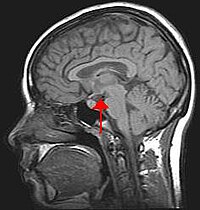
Photo from wikipedia
Tamoxifen (TAM) is a selective estrogen receptor modulator, widely used in the treatment and prevention of estrogen-dependent breast cancer. Although with great clinical results, women on TAM therapy still report… Click to show full abstract
Tamoxifen (TAM) is a selective estrogen receptor modulator, widely used in the treatment and prevention of estrogen-dependent breast cancer. Although with great clinical results, women on TAM therapy still report several side effects, such as sexual dysfunction, which impairs quality of life. The anatomo-functional substrates of the human sexual behavior are still unknown; however, these same substrates are very well characterized in the rodent female sexual behavior, which has advantage of being a very simple reflexive response, dependent on the activation of estrogen receptors (ERs) in the ventrolateral division of the hypothalamic ventromedial nucleus (VMNvl). In fact, in the female rodent, the sexual behavior is triggered by increasing circulation levels of estradiol that changes the nucleus neurochemistry and modulates its intricate neuronal network. Therefore, we considered of notice the examination of the possible neurochemical alterations and the synaptic plasticity impairment in VMNvl neurons of estradiol-primed female rats treated with TAM that may be in the basis of this neurological disorder. Accordingly, we used stereological and biochemical methods to study the action of TAM in axospinous and axodendritic synaptic plasticity and on ER expression. The administration of TAM changed the VMNvl neurochemistry by reducing ERα mRNA and increasing ERβ mRNA expression. Furthermore, present results show that TAM induced neuronal atrophy and reduced synaptic connectivity, favoring electrical inactivity. These data suggest that these cellular and molecular changes may be a possible neuronal mechanism of TAM action in the disruption of the VMNvl network, leading to the development of behavioral disorders.
Journal Title: Neurobiology of Disease
Year Published: 2018
Link to full text (if available)
Share on Social Media: Sign Up to like & get
recommendations!